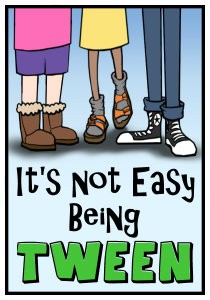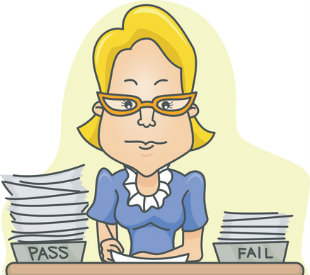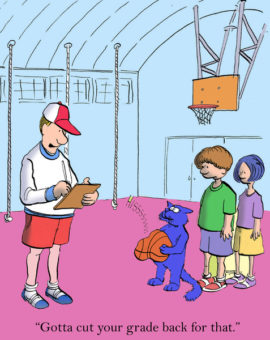Six Steps Toward Fair and Accurate Grading
A MiddleWeb Blog
 Another school year ended this week. With that comes the dreaded chore of entering students’ final grades.
Another school year ended this week. With that comes the dreaded chore of entering students’ final grades.
In a perfect world, teachers would be able to “just” teach and the concept of recording grades would not exist. Teachers would teach for the purpose of sharing their content expertise with students who worked hard for the joy of gaining knowledge.
Alas, we do not live in a perfect world.
Grading is inherently a subjective process. There are many ways to make it less so, but there are so many factors that go into assigning a final report card grade that my priority is to make sure the grades I record are as valid and reliable as possible.
Some schools have taken steps towards more equitable, valid grades such as using Standards Based Grading, allowing re-dos and re-takes, building portfolios, and utilizing student-led conferences. However, the majority of schools have not.
Most schools still use the traditional system we all grew up with. The good news is that even if we are among the multitudes who don’t teach in a grade-less utopia, there are steps we can all take to become more accurate and equitable in our grading policies.
My Own Search for Fair and Accurate Grading
I used to teach an Assessment and Evaluation teacher education course at Eastern Michigan University. One of my greatest influences when developing this course (as well as my personal grade policy) was Rick Wormeli. His list of Grading Malpractices in the first edition of Fair Isn’t Always Equal struck a chord with me when I first read them, and I try to implement his suggestions with as much fidelity as possible within the confines of my current teaching situation.
Other experts I consult often are W. James Popham, Ken O’Connor, Susan Brookhart, and James McMillan. I have boiled down what I have learned about responsible grading from these experts and how I incorporate them into my own practice into six “first steps” all of us can take.
1. Establish Clear Criteria for Graded Work
Students can’t hit a target they can’t see, so be sure to thoroughly explain and model what a student will be expected to do and how you will assess the final product. If you use a rubric (I use single-point rubrics for larger projects and written assignments), provide it when you explain the assignment so that all involved understand the expectations.
2. Reconsider the Zero

Now, for the rare occasion when no credit is earned, I use the highest “F” score available to me, which in my case is a 59%. This ensures that one blip does not destroy a student’s entire marking period grade and does not result in a lower grade that does not necessarily represent the child’s knowledge of the content.
3. Don’t Include Homework and Formative Assessment
Athletes are not graded on daily practice because they use that time and those drills to improve their performance under the guidance of a good coach. They are only scored during the game when it counts. This is analogous to why homework and formative assessments should count for very little in the final grade.
Other reasons to make homework a small part (if any part) of the final grade are:
First, the only level playing field is your classroom. Unless you can ensure that all students have equal access to time, adult assistance, technology, and materials outside of school (and of course you cannot), you should not make work done outside of your room a significant portion of their grade.
Second, my rule of thumb with homework is “if it can be copied, it will be.” The majority of homework I see assigned does not incorporate original thought, but rather practicing a skill. (See “practice” above.)
Third, we have all had students who rarely or never do homework but earn high marks on final assessments. This just shows that this student does not need to complete a worksheet to understand a topic and his or her grade should not be lowered as a result of failing to do unneeded practice.
4. Consider Using Weighted Grade Categories
Most teachers I know are married to the idea of grading using straight points. A straight-points system is easy for students, teachers, and parents to understand because it just means that all points a student earned are divided by the maximum earnable points.
There are two points to make here:
First, if one goes back and looks at the grade calculations at the end of the marking period, a straight-points system almost always skews heavily toward homework and classwork and not toward summative assessments. Unless teachers are so supremely organized that they know in advance every single item of graded work and can determine how to make sure that final tests, quizzes, and projects are worth the majority of points, the math rarely works out to “fair and accurate” in the end.
Second, a category system (for example, Formative Assessments are worth 25% of final grade and Summative Assessments are worth 75%) allows for flexibility in number and types of assignments. The number of points per item is irrelevant as they get averaged by category at the end.
Yes, this does take some explaining by the teacher at the outset so that students and parents understand the concept, but I have had much more success using a category system than total points. It also makes the final grade more reflective of the child’s actual abilities because – for example – a child cannot earn an A in the course merely by completing all the homework and getting Cs on tests and quizzes.
5. Grade Students as Individuals
Though it is becoming less common, there are still examples of students being graded on a curve in order to force a certain distribution of scores. This is unethical for many reasons. Another unethical practice is assigning group grades to group work. There are many ways to avoid this, but the easiest is to consider group work as ungraded practice as there is almost no way to determine an accurate group score.
6. Only Include Academic Performance in Grade
First, extra credit should be eliminated. Every fall, I see teachers post on social media about giving students extra credit for bringing in hand sanitizer, paper, or tissues. This is an unethical use of points. Likewise, giving extra credit or bonus points on a test or quiz can skew the final test score and does not represent what a student learned.
Extra credit should never be assigned for out of class work for the same reasons listed under homework above. Finally, incorporating extra credit allows students to earn more than 100% for the course which should never be mathematically possible.
Second, behavior should not be incorporated into final scores. Measuring factors such as academic dishonesty, late work, missing homework, using an improper heading on a paper, forgetting their name, classroom behavior, or class participation ends up painting a misleading picture of the student as a learner. What’s more, it sets grades up to be punitive in nature, and grades should never be used as rewards or punishments.
These First Steps Can Make a Difference
As I shared earlier, I taught an entire semester course in this material and there is so much more to share. But taking even these first baby steps toward improving classroom grading practices will help ensure that our classroom scores are more fair and more accurate and more focused on authentic academic growth and development.





































I have a mixed reaction. While giving a 0 weights that grade heavily down, giving a 59 for work not done is a joke and thoroughly distorts the student’s performance in the other direction. In addition it sends the wrong message to the student. I teach math at an alternative high school and my standard is that every assignment must be done in order to pass the class, regardless of the overall percentage. I accept assignments until the end of the day on the last day of the quarter. Kids know the standard and they meet it. In a school where students are placed because they aren’t “making it” in regular school, 95% of my kids pass (it takes a 70% average to pass). Academically I push them to their performance limit. My standards are clear, kids know them, and almost every one meets them. You have to give the kids the choice to pass or fail. If they choose to fail it’s on them.
I strongly agree with grades being based only on academic performance. When such things as behavior are included the grade becomes meaningless. Behavior needs to be treated separately.
I also strongly believe in no extra credit. My impression is that teachers who give extra credit give rote “go through the motions” assignments to allow the student to pretend to do work to make up for not doing assignments in the first place.
Mr Krause—What a commentary! Just because an “expert” proclaims something, it is not necessarily so. I disagree with Rick Wormeli (whom I respect) and agree with you, Mr Krause, in that work not done should NOT be credited as 59%. In my professional opinion, ATTEMPTED work need be “rewarded with 59% if it is inferior. Discounting homework, or making it 5% of the final grade (as Wormeli suggests) is a poor practice if you have practiced the skill thoroughly in the classroom.
More importantly, I feel this is an inequitable practice for those who DO take homework seriously! Remember being equitable works for the “serious” student, as well as the “disadvantaged” few.
The main and irrefutable argument for not using zeros for missing work is the mathematical argument. We teach (usually in grade 5) about measures of central tendency and about ratio and equal difference. If we use a scale with 10 or 11 points for A B C and D and 60 points for an F and average in the ultimate outlier zero that is mathematically incorrect.
Teachers have a moral, ethical, and professional responsibility to use in their grade books the principles taught in math classes. Thus, if we are using the scale described above we MUST use 50% for missing work. This is simply a symbolic representation to make the math make sense and doesn’t mean that the student knows or understands half. Also, note that if they only get 50’s they fail!
With regard to homework, If it is diagnostic or practice it has no place in grades; if it is extension or integration it may legitimately be part of grades. In the same way that practice gets feedback in sports and no scores, practice in or out of the classroom should get feedback, not scores, and has no place in grades. We should grade achievement (what we see on summative assessments), not “the work.”
We experimented this year with not counting homework in the grades. The result: they didn’t do it
Lori, I just wanted to say kudos for giving it a try. It’s unfortunate that it did not work for your team. Perhaps you could try instead just awarding a small number of points for completing the assignment instead of not counting it at all. You could also grade the homework if that improves the completion rate, but make sure that those points are a very small portion of their final grade–enough to make a difference in their grade if they don’t do it, but not so much that their final grade is skewed higher by it.
It was a policy dictated from above. I could have predicted the results. We are only supposed to count assignments that we grade. (we generally don’t have time to grade homework) We compensated by giving unannounced homework quizzes where I let them use their homework during the quiz. (they get to ask questions first). I am considering doing just what you suggest, counting the homework for completion, but for a small number of points so it doesn’t affect their grade too much.
Ahh, policy dictated from above. I understand that. I hope you find something that works. Please keep me posted.
In our HS math department homework is 5%. However students cannot take their summative assessment until this practice homework (often they have work time in class) is complete. At first it’s a bit of a pain to monitor, but honestly students buy into the concept.
The only thing that counts toward the grade in my class are the end of unit summative assessments. Classwork/Homework goes in as completed “1” or incomplete “0” in an unweighted “Process” category of my grade book for students/parents to see. Those who don’t complete wouldn’t complete if it counted as a test grade. The fact that these assignments are not graded is not affecting my students’ completion of assignments at all.
How did not doing your homework affect their performance on assessments?
I like this concept, Jason. I’d be interested to hear how the parents and students respond as well as the answer to. Ike’s question. Also, are you the only one doing this in your school, or is it across the board?
Most teachers I know who stop scoring homework say that more students do it than when it was included in grades. You need to get your students to understand (as they do in band and basketball), that everything counts/matters, some as practice (gets feedback, not scores), some as performances (gets scores that are used to determine grades).
Great thoughts on assessment here. The rubrics part is an integral part of my class. I use a 4 point grading system on all formal written (and oral) assignments and students clearly know the criteria and work towards achieving the best they can. We discuss what a “3” quality piece of work would look like and compare with a “2” and a “4”.
As for bonus work I am clearly in support of it, however I always make it part of what the course is about (e.g. not bringing kleenex but doing something that will improve learning in my courses). Some students eagerly embrace this and will work very hard to take on a bonus project. It is extra work for them and it defines an attitude that demonstrates they are willing to learn more in the course work. I say why not get rewarded for that? It also helps me at the end of the year to define their grades better if i have to make a decision to give a 78% or an 80%.
In any meaningful way, how do you distinguish between 78 and 80%? Bottom line – you can’t! We need to eliminate 5 from assessment and grading.
I am afraid I cannot agree with many of the best practices proposed here.
Maria, I can respect that. These are best practices I believe in after many years of research into the topic. At first, some of them did not make sense to me either, but seeing them in action made me a believer. I encourage you to read the work of Rick Wormeli, Ken O’Connor, or W. James Popham. Perhaps the way they explain these concepts is clearer than I could be in a brief post. Bottom line is that you need to use what works for you and your students. These are just ideas that make sense and work for me.
Here’s an excerpt from the new edition of Rick Wormeli’s much-read Fair Isn’t Always Equal. It looks at three grading “malpractices,” including giving a meaningful number of points for non-academic things. You’ll get a feel for Wormeli’s perspectives. Also search YouTube to hear him talk about some of these issues: https://www.middleweb.com/37435/fair-isnt-always-equal-3-grading-malpractices/
I teach Algebra 1. I allow re-takes and use Standards Based Grading. I count homework 15% and Assessments 85%. I post a chart at the beginning of each quarter with names vertical and scores starting at 96% and going down 4% each. If a student cannot show me a homework paper that “appears” to be his or her work they put a check on the chart and their new homework grade is 96%. I just put those scores in at the end of the quarter. I answer questions, rarely grade homework
What if I’m trying to assess a behavioral skill in a CTE-type class? Ability to meet deadlines, for example, is a huge part of my yearbook class, but that means students lose points for late work, because the skill IS being on time. I do it on a 4-point scale to avoid pits students can’t get out of, but they do get a zero if they do none of the work, because the key to succeeding in something like yearbook is participation. I have tried to think of ways around this, but I can’t figure one out. I’d love your thoughts.
I am a special education teacher, teaching in 6th grade. Many of my students have difficulty with homework; sometimes because of behavior, and sometimes because of difficulty understanding the concepts. For years this has caused many problems with grades, even though students understood concepts. This was also the case with the at-risk students.
My math teacher and I have decided on grades being based solely on tests and quizzes. When they turn in their test, they staple the practice worksheets that were assigned as homework (usually time is provided in class for this), the two quizzes, and the review to their test. This way we have evidence as to what the student understood and practiced.
This has helped hugely in achieving a more accurate grade. Retakes are allowed until they achieve mastery, but must be arranged by the student, and done on their own time during lunch (or multiple lunches if it takes that long).
If not scored into a grade how would academic dishonesty, late work, missing homework, classroom misbehavior, and lack of participation, etc. be addressed? In a job, these behaviors would earn the grade of a pink slip. We must teach children that their actions (an inactions) have consequences.
So this is new to me but what I figure you can incentivize behavior traits you want by a few ways, first you could use a classroom point system or other system that isn’t connected to the grade book that you, the student, and parent are in accordance to. This way you could still provide consequences (possible loss of privileges in class) based on behavior but their grade reflecting mastery of a subject isn’t swayed.
Another way I have read is you can incorporate these attributes into the grade book but make them weigh less in the overall grade.
Overall Rick definitely wants teachers to do what works best for them and their students. This idea of including only what students have mastered in the content area of what you teach makes sense. Back at my elementary school we had grades on the report card separated, kids would get a behavior/participation grade, then totally separate they’d get the subject mastery grade.
These are great suggestions, Ethan.
Let’s not do this – we should be minimizing extrinsic motivation and maximizing intrinsic motivation. Good relevant read – the section of Daniel Pink’s book “Drive” for parents and teachers.
Ken, I absolutely agree with focusing on intrinsic versus extrinsic motivation. I don’t use points to incentivize behavior or award extra credit of any kind, but I know many educators who do so. I appreciated how Ethan wanted to separate behavior from an academic grade—similar to what is done is most elementary schools—and I wanted to acknowledge that. If teachers are determined to assign a measure to non-content or academic areas (a practice I believe should be eliminated), then it should at least be separated from a content-mastery mark. I appreciate your contributions and responses to this post. Your work has been very influential on my practice. Thank you.
I agree completely.